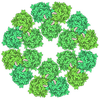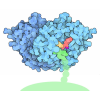[English] 日本語
 Yorodumi
Yorodumi- PDB-8c0b: CryoEM structure of Aspergillus nidulans UTP-glucose-1-phosphate ... -
+ Open data
Open data
- Basic information
Basic information
| Entry | Database: PDB / ID: 8c0b | ||||||
|---|---|---|---|---|---|---|---|
| Title | CryoEM structure of Aspergillus nidulans UTP-glucose-1-phosphate uridylyltransferase | ||||||
 Components Components | UTP--glucose-1-phosphate uridylyltransferase | ||||||
 Keywords Keywords | SUGAR BINDING PROTEIN / NDP-sugar pyrophosphorylases / UDP-Glc pyrophosphorylases / cell wall biosynthesis / Aspergillus nidulans. | ||||||
| Function / homology |  Function and homology information Function and homology information(1->6)-beta-D-glucan biosynthetic process / sporulation / UTP-glucose-1-phosphate uridylyltransferase / UTP:glucose-1-phosphate uridylyltransferase activity / trehalose biosynthetic process / UDP-alpha-D-glucose metabolic process / glycogen biosynthetic process / glycogen metabolic process / cytoplasm Similarity search - Function | ||||||
| Biological species |  | ||||||
| Method | ELECTRON MICROSCOPY / single particle reconstruction / cryo EM / Resolution: 3.98 Å | ||||||
 Authors Authors | Han, X. / D Angelo, C. / Otamendi, A. / Cifuente, J.O. / de Astigarraga, E. / Ochoa-Lizarralde, B. / Grininger, M. / Routier, F.H. / Guerin, M.E. / Fuehring, J. ...Han, X. / D Angelo, C. / Otamendi, A. / Cifuente, J.O. / de Astigarraga, E. / Ochoa-Lizarralde, B. / Grininger, M. / Routier, F.H. / Guerin, M.E. / Fuehring, J. / Etxebeste, O. / Connell, S.R. | ||||||
| Funding support |  Spain, 1items Spain, 1items
| ||||||
 Citation Citation |  Journal: mBio / Year: 2023 Journal: mBio / Year: 2023Title: CryoEM analysis of the essential native UDP-glucose pyrophosphorylase from reveals key conformations for activity regulation and function. Authors: Xu Han / Cecilia D'Angelo / Ainara Otamendi / Javier O Cifuente / Elisa de Astigarraga / Borja Ochoa-Lizarralde / Martin Grininger / Francoise H Routier / Marcelo E Guerin / Jana Fuehring / ...Authors: Xu Han / Cecilia D'Angelo / Ainara Otamendi / Javier O Cifuente / Elisa de Astigarraga / Borja Ochoa-Lizarralde / Martin Grininger / Francoise H Routier / Marcelo E Guerin / Jana Fuehring / Oier Etxebeste / Sean R Connell /   Abstract: Invasive aspergillosis is one of the most serious clinical invasive fungal infections, resulting in a high case fatality rate among immunocompromised patients. The disease is caused by saprophytic ...Invasive aspergillosis is one of the most serious clinical invasive fungal infections, resulting in a high case fatality rate among immunocompromised patients. The disease is caused by saprophytic molds in the genus , including , the most significant pathogenic species. The fungal cell wall, an essential structure mainly composed of glucan, chitin, galactomannan, and galactosaminogalactan, represents an important target for the development of antifungal drugs. UDP (uridine diphosphate)-glucose pyrophosphorylase (UGP) is a central enzyme in the metabolism of carbohydrates that catalyzes the biosynthesis of UDP-glucose, a key precursor of fungal cell wall polysaccharides. Here, we demonstrate that the function of UGP is vital for (UGP). To understand the molecular basis of UGP function, we describe a cryoEM structure (global resolution of 3.5 Å for the locally refined subunit and 4 Å for the octameric complex) of a native UGP. The structure reveals an octameric architecture with each subunit comprising an N-terminal α-helical domain, a central catalytic glycosyltransferase A-like (GT-A-like) domain, and a C-terminal (CT) left-handed β-helix oligomerization domain. UGP displays unprecedented conformational variability between the CT oligomerization domain and the central GT-A-like catalytic domain. In combination with activity measurements and bioinformatics analysis, we unveil the molecular mechanism of substrate recognition and specificity for UGP. Altogether, our study not only contributes to understanding the molecular mechanism of catalysis/regulation of an important class of enzymes but also provides the genetic, biochemical, and structural groundwork for the future exploitation of UGP as a potential antifungal target. IMPORTANCE Fungi cause diverse diseases in humans, ranging from allergic syndromes to life-threatening invasive diseases, together affecting more than a billion people worldwide. Increasing drug resistance in species represents an emerging global health threat, making the design of antifungals with novel mechanisms of action a worldwide priority. The cryoEM structure of UDP (uridine diphosphate)-glucose pyrophosphorylase (UGP) from the filamentous fungus reveals an octameric architecture displaying unprecedented conformational variability between the C-terminal oligomerization domain and the central glycosyltransferase A-like catalytic domain in the individual protomers. While the active site and oligomerization interfaces are more highly conserved, these dynamic interfaces include motifs restricted to specific clades of filamentous fungi. Functional study of these motifs could lead to the definition of new targets for antifungals inhibiting UGP activity and, thus, the architecture of the cell wall of filamentous fungal pathogens. | ||||||
| History |
|
- Structure visualization
Structure visualization
| Structure viewer | Molecule:  Molmil Molmil Jmol/JSmol Jmol/JSmol |
|---|
- Downloads & links
Downloads & links
- Download
Download
| PDBx/mmCIF format |  8c0b.cif.gz 8c0b.cif.gz | 637.4 KB | Display |  PDBx/mmCIF format PDBx/mmCIF format |
|---|---|---|---|---|
| PDB format |  pdb8c0b.ent.gz pdb8c0b.ent.gz | 535.2 KB | Display |  PDB format PDB format |
| PDBx/mmJSON format |  8c0b.json.gz 8c0b.json.gz | Tree view |  PDBx/mmJSON format PDBx/mmJSON format | |
| Others |  Other downloads Other downloads |
-Validation report
| Arichive directory |  https://data.pdbj.org/pub/pdb/validation_reports/c0/8c0b https://data.pdbj.org/pub/pdb/validation_reports/c0/8c0b ftp://data.pdbj.org/pub/pdb/validation_reports/c0/8c0b ftp://data.pdbj.org/pub/pdb/validation_reports/c0/8c0b | HTTPS FTP |
|---|
-Related structure data
| Related structure data |  16357MC M: map data used to model this data C: citing same article ( |
|---|---|
| Similar structure data | Similarity search - Function & homology  F&H Search F&H Search |
- Links
Links
- Assembly
Assembly
| Deposited unit | 
|
|---|---|
| 1 |
|
- Components
Components
| #1: Protein | Mass: 57634.672 Da / Num. of mol.: 8 / Source method: isolated from a natural source / Source: (natural)  References: UniProt: C8VK50, UTP-glucose-1-phosphate uridylyltransferase |
|---|
-Experimental details
-Experiment
| Experiment | Method: ELECTRON MICROSCOPY |
|---|---|
| EM experiment | Aggregation state: PARTICLE / 3D reconstruction method: single particle reconstruction |
- Sample preparation
Sample preparation
| Component | Name: UTP--glucose-1-phosphate uridylyltransferase / Type: COMPLEX / Entity ID: all / Source: NATURAL | ||||||||||||||||||||
|---|---|---|---|---|---|---|---|---|---|---|---|---|---|---|---|---|---|---|---|---|---|
| Molecular weight | Experimental value: NO | ||||||||||||||||||||
| Source (natural) | Organism:  | ||||||||||||||||||||
| Buffer solution | pH: 7.8 Details: 50 mM Tris, 200 mM NaCl, 2 mM Beta-mercaptoethanol, pH 7.8 | ||||||||||||||||||||
| Buffer component |
| ||||||||||||||||||||
| Specimen | Conc.: 0.18 mg/ml / Embedding applied: NO / Shadowing applied: NO / Staining applied: NO / Vitrification applied: YES / Details: The sample was monodisperse | ||||||||||||||||||||
| Specimen support | Grid material: COPPER / Grid mesh size: 300 divisions/in. / Grid type: Quantifoil R1.2/1.3 | ||||||||||||||||||||
| Vitrification | Instrument: FEI VITROBOT MARK IV / Cryogen name: ETHANE |
- Electron microscopy imaging
Electron microscopy imaging
| Experimental equipment |  Model: Titan Krios / Image courtesy: FEI Company |
|---|---|
| Microscopy | Model: FEI TITAN KRIOS |
| Electron gun | Electron source:  FIELD EMISSION GUN / Accelerating voltage: 300 kV / Illumination mode: OTHER FIELD EMISSION GUN / Accelerating voltage: 300 kV / Illumination mode: OTHER |
| Electron lens | Mode: BRIGHT FIELD / Nominal defocus max: 3000 nm / Nominal defocus min: 500 nm |
| Image recording | Electron dose: 60 e/Å2 / Film or detector model: GATAN K3 BIOQUANTUM (6k x 4k) |
- Processing
Processing
| Software |
| ||||||||||||||||
|---|---|---|---|---|---|---|---|---|---|---|---|---|---|---|---|---|---|
| CTF correction | Type: PHASE FLIPPING AND AMPLITUDE CORRECTION | ||||||||||||||||
| 3D reconstruction | Resolution: 3.98 Å / Resolution method: FSC 0.143 CUT-OFF / Num. of particles: 126375 / Symmetry type: POINT |
 Movie
Movie Controller
Controller


 PDBj
PDBj

